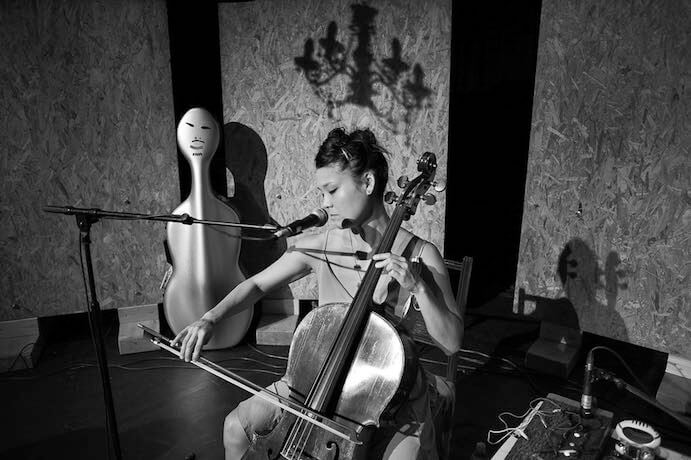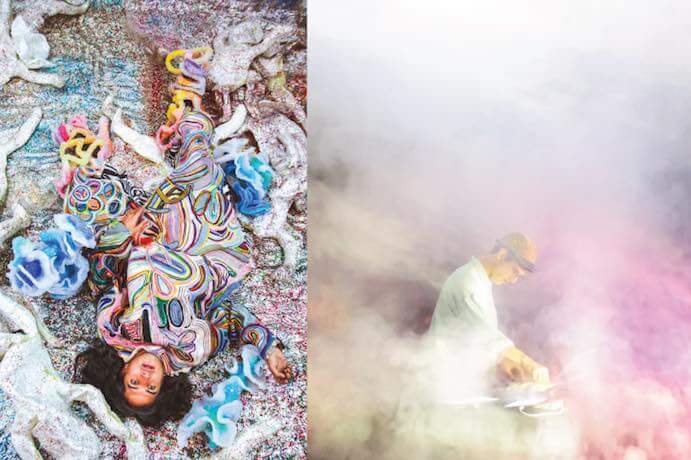On January 19th, the night before the inauguration of Donald Trump, an assortment of sounds ranging from quirky to downright terrifying could be heard at ISSUE Project Room as past artists-in-residence created sounds with their voices, bodies, and an array of manmade objects. Curators Lea Bertucci and Chris McIntyre stressed the importance of presenting underrepresented artists—many of whom are underrepresented because of gender, race, or sexual orientation—and continuing to do so under the new administration. Resistance, they urged, can occur within “a liminal space both reflexive and reflective through a collaborative format.” This space was to be created, explored, and tested to its limits over the course of the evening as a range of artists brought their sounds into contact and dialogue with each other. Although many of the sounds and experiences made me cringe, overall it was a cathartic expression of the tension and raw fear pervading the eve of the inauguration of an anti-immigrant, anti-woman, anti-LGBT, white supremacist administration.
The first piece on the program was an unnamed, forty-minute-long collaboration between Audrey Chen, Joan La Barbara, and Miguel Frasconi. The improvisation evolved from throaty vocal sounds and the delicate tapping of glass and stone into a jurassic soundscape of splashing, screeching, and rattling. Chen, somehow capable of shifting seamlessly from grainy groans to throat clicks uncannily reminiscent of the sounds of a woodpecker, inhabited spaces at the fringes of human vocality and aurality. Meanwhile, La Barbara hummed and babbled and screeched in a manner both abject and graceful. Frasconi was the only one of the trio to employ external objects: at various points he scraped and rubbed and chimed glass rods against the sides of a fishbowl full of water, used the glass rods as a straw with which to send flutey sounds skimming across the top of the water, and ground metal plates against each other. The resulting chaos sounded like a blend of Meredith Monk vocal acrobatics, Stockhausen’s extraterrestrial Stimmung, and a pterodactyl brought back from the dead.

Audrey Chen
Any performance will feel like a letdown after this one, but MV Carbon‘s collaboration with Bradley Eros, The Mystery of Spiders, felt like a drastic letdown in its clumsy pretentiousness. The concept sounded appealing—the creation and sonification of scores based on spiderwebs—yet the actualization was cringeworthy. The combination of scraggly feedback at painfully loud volumes, projections of insects copulating, and distracting lightscapes felt over-the-top and incoherent. The narrative content, driven forward by captions such as “Now Scorpion Battles Scorpion” and “Psychedelic Drug Effects on Spiders,” was immature and condescending. This sort of wry, tongue-in-cheek detachment from human reality works in certain contexts, but felt out of place on such a solemn night.
The final performance of the evening was similarly off-putting, though its communication of raw anguish felt less indulgent than the narrative of The Mystery of Spiders. Raul de Nieves, overlaying his own flailing performance art with Doron Sadja‘s multi-channel spatialized sound, gave voice to all of us on the eve of a sexual predator’s inauguration as he screamed over and over for roughly half an hour. Low vibrations and rumbling electronics shook us to our core as smoke and strobe effects enclosed the space. After the initial shock value, the performance became very monotone, with little variation in volume or timbre. The electronics rumbled as De Nieves screamed; he screamed while wearing a mask, while standing on a ladder, while crawling along the floor, etc. At the close of the performance, De Nieves declared that “Evil is not real; evil is a lie.” Although perhaps intended as a statement of defiance, this sentiment felt privileged and out of place. We should now be fully acknowledging and resisting evil, rather than denying its very existence.























